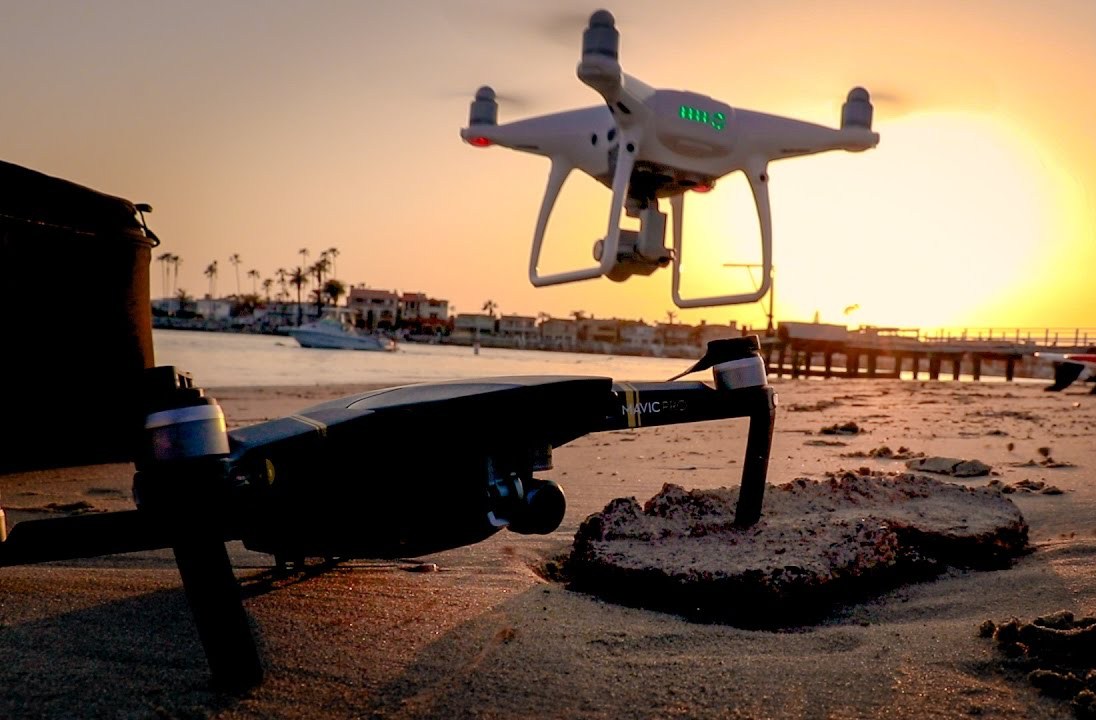For years now, people have heard me raving about consumer “drones.” Or more accurately, “quadcopters.” These expensive toys are nothing short of the greatest gadgets of my lifetime. They are marvels of technology, that blow my mind every time I think about all of the technology they leverage to work as amazingly as they do.
That said, I felt the need to give any drone “noobs” out there a Five Point Primer on becoming a drone owner/pilot.
1. This Is Still Very Much, A Hobby
I say this because it’s easy to get lulled into thinking that whatever you decided is your quadcopter of choice (more on that in point #2) it’s just a fun thing to fly around and take pictures and videos with. It’s not. You are now entering a bonafide hobby, in which you will experience lots of excitement, but also a bunch of frustration, anguish, and sometimes hours of lost time. Read every manual and tutorial you can. Watch every well produced tutorial video on your particular drone on-line. Learn every little nook and cranny of the dense app that controls your drone. Test out every single mode. Test the obstacle avoidance. Practice takeoffs and landings. Do controlled tests in windy conditions in open fields, at just above head level to see how your craft reacts. In other words, LEARN your hobby. That is, unless you just want to fly the thing into a tree, or panic when something goes wrong (which happens ALOT) and you watch the craft go flying off into the great beyond. Do NOT let anybody fly it, unless you are there to gently coach them, and it is a low obstacle environment (i.e. wide open field, or 200’+ in the air where there’s nothing to hit). Accept the fact you will need to do troubleshooting, firmware updating, problem solving, and do it regularly.
2. Get Something from DJI
Yeah, I know I will get plenty of people touting how good, how superior, and how awesome “Brand XYZ” is when it comes to their drones. And that may be true. I haven’t flown any others. All I know is that DJI was the first mass marketer of hi-tech quadcopters, and they are still the top dog by a longshot. This means a few things. 1) They have a vested interest in staying top dog, so they generally do a good job of customer service, helping you get your drone back quickly if you send it in for repairs, etc. 2) They have learned from all of their screw-ups and design flaws from previous models. For example, GoPro decided to get into the drone biz because the early DJI Phantoms required you to supply your own GoPro, so when DJI started making their own cameras, GoPro got suckered into saying “oh yeah, well, then we’ll make drones too!” It’s been a disaster. The GoPro Karma drone has been widely panned, and I wouldn’t be shocked if they never made another one (even though they say they will. We’ll see.) DJI now has three great levels of consumer drones. The Spark is a great entry drone, with hard fixed wing arms and a sturdy 2-axis gimbal and non-4k camera. The Mavic is my current drone and it’s amazing. Small and foldable, but full featured with 4K imagery. It’s amazingly good for being so small in high wind conditions. And then the full sized Phantom 4 lineup. DJI is dusting everybody in this field right now. Stick with the best.
This guy is pretty hilarious, and his tech reviews on YouTube are the best!
3. Taking Off and Landing Are Still the Two Most Important Things
This is the same as it is for any other aircraft that carries human beings beyond the surly grasp of earth’s gravity. Your two biggest perils, are at the moment of departure and again upon safe arrival. Period. Full stop. Soak that in. I say that because it’s easy to get cocky on both fronts. I often will get lazy and launch my drone from a flat spot, in between some trees, or dangerously close to the side of my house. I take for granted that I will have full control of the aircraft when it comes time to land it at home, and I can make sure to avoid those things coming down. Uh-unnnn. Not ALWAYS. You will be amazed (and panicked) at times when your app crashes, or your drone “disconnects” from the controller. In that case, your drone is programmed to come home, but two key factors are involved. 1) Did you set the return home height so that you’ll avoid ALL trees? 2) Is your “home point” a clear flat surface with plenty of space for the onboard software to land? And I have crashed my drone trying to be fancy landing it on the roof of my car. Stupid. One time, a gust of wind, caught it at the very last moment and it clattered about 5 feet to the ground off the edge of my car. Luckily, there was only cosmetic damage, but it was totally un-necessary.
4. When In Trouble, Go Up!
This took me a few panic-crashes to figure out, but I finally learned. If you must land in a tight spot (semi-dense forest) or on a moving something (boat) and you are struggling with the landing or think you might smash into something….. GO UP. Quickly! 99% of the time, there will be nothing above you, and once you are up 50-100 feet, you can let the drone sit there, while you re-think your landing strategy. UP is almost always safe. I once tried to land my drone a picnic table on the deck of our beach house in high winds, because you know, 1 week with a drone and everybody think’s they are Tom Cruise in “Top Gun.” I GOT IT!!! Well, I donked the thing off face of the house in a last second panic, and watched it crash onto the deck and fuck up the gimbal. Good job, dummy. Even though I launched from that table (stupid) I could have easily just aborted the dicey landing by zooming back upward, then gone downstairs to the street while the drone was hovering high above, and guided it down safely. Instead, it $75 plus parts and shipping. Dummy.
5. Never Forget: You Didn’t Get Into Drones to SAVE Money
Yes, yes, yes. There will be times when you think this toy is a huge waste of cash. You will start to get a bit jaded at seeing what your neighborhood, or a golf course, or a river, or whatever looks like from above. You will crash your drone. It will require repairs. It will cost money. But guess what? Who cares? It’s still so fucking cool to have one, you will be glad you do. If you are like me, you will marvel at how this is not just all possible, but how is it still LEGAL!? When I was a kid, only a few dedicated hobbyists had remote controlled airplanes (circa 1978) and they ran on MINIATURE fucking ether powered engines that were damn near impossible to start, loud as shit, and ran for approximately 3 minutes. The planes they powered took the nerves of John Fucking Glenn to successfully pilot, and landing them safely was just a rumor. They were still the coolest thing going. So this age of drones we live in now…… my goodness people. What a hoot.
Respect others property, privacy, and obey all FCC regulations. Understand that it’s likely more and more absurd airspace restrictions will be introduced soon, so let’s fly where we can, when we can. Understand that even cooler drones will keep coming out, model year after model year. So what? Sit out a cycle, and get the newest one every OTHER model roll-out.
As this hilarious spoof video says: “Fly Your Money.” I couldn’t agree more!






Maybe an eBay buying guide would be helpful as well
This is a very well thought out and smart beginner guide to Quads. If you follow these simple suggestions I can assure you Czabe just saved you between $200 – $1000 of mistakes and bad purchases.
I have been flying drones for over 3 years and have been racing them competitively for 2. When someone new to the hobby asks what drone they should buy I usually ask what they are looking to do with them. Boiled down, drones have two categories.
The first is under the AP or aerial photography class. This is what Czabe, to my knowledge, predominantly flies. These are usually bigger rigs with high definition cameras attached by a gimbal to give you beautiful and shake free footage from the sky. The flight times are relatively high (30 mintues) and the controls are unworldly easy to handle. Someone who has never flown a drone could likely pick up the sticks and successfully fly the drone with a short instructional from someone in the know.
The Second “class” of drones is the FPV or First Person View type. This is they kind of drone where you use a small camera from the front of the drone to send a signal back to a set of goggles that the pilot wears giving the feeling of sitting in the cockpit of the quad. This style of quad is much more difficult to fly as they do not have all of the bells and whistles that the DJI brand has. While the controls are the same (throttle, pitch, roll, yaw) the FPV quads do not have GPS, sophisticated self-leveling system, or near the flight time as the AP rigs. The tradeoff however is a lower weight, higher speed, increased agility, and an increased resilience. Less sensitive equipment means less chance to break something. Most all of these FPV quads are built by the pilots that fly them from parts purchased separately. This allows customization and getting the exact quad you want to fly.
Because of the attributes of the FPV quads, FPV racing was born. This is a new sport where pilots are timed and have to navigate a course laid out in a field passing through gates or flags. This has spawned several professional racing leagues including the DRL which has been picked up by ESPN. Simply Youtube “FPV Racing” and see what it’s all about. When racing, the quads often only last around 2-3 minutes, but I can attest that those will be some of the most exhilarating 2 minutes of your life, save your honeymoon. Zing!
As Czabe points out, this is a hobby. There is a huge learning curve and financial investment. Drones are easily one of the most exciting things you can do that is still currently legal. Be prepared to be frustrated, elated, and proud all at the same time while being physically unable to remove the smile from your face. Once you do decide to dive into that rabbit hole called drones we are not responsible for any neglect your family receives for your new found love.
If floating around taking pictures doesn’t seem to be your jam then I highly recommend looking into FPV racing. This stuff is like a Phantom on crack and a 6 pack of Red Bull. Simply type “FPV racing” in youtube and take a look at what these machines are truly capable of. There are several professional leagues for drone racing including DRL featured on ESPN.
I started my FPV life with a Phantom v1.1.1, I had fun but quickly became bored remaining stationary in a spot above the earth. I came across a video of some guys flying quads in the woods and shortly thereafter sold my phantom to dive into the FPV racing world.
please disregard the last two paragraphs. 🙁 that was my early thoughts in writing.